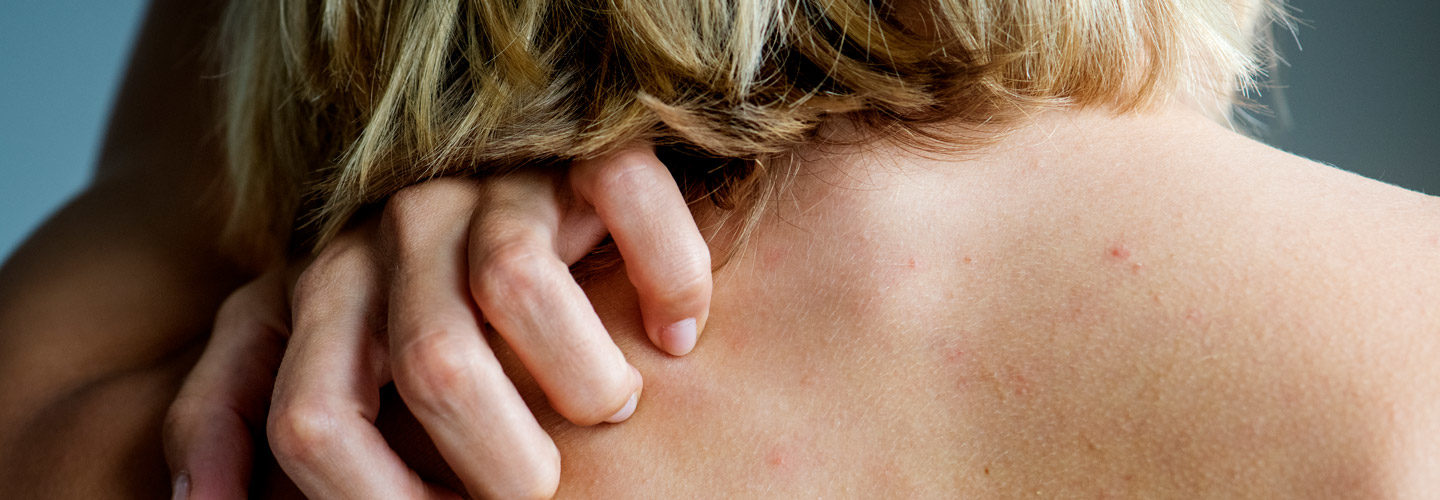Psoriasis
Psoriasis Types & Treatment
Psoriasis is a skin condition that creates red patches of skin with white, flaky scales. It most commonly occurs on the elbows, knees and trunk, but can appear anywhere on the body. The first episode usually strikes between the ages of 15 and 35. It is a chronic condition that will then cycle through flare-ups and remissions throughout the rest of the patient’s life. Psoriasis affects as many as 7.5 million people in the United States. About 20,000 children under age 10 have been diagnosed with psoriasis.
In normal skin, skin cells live for about 28 days and then are shed from the outermost layer of the skin. With psoriasis, the immune system sends a faulty signal which speeds up the growth cycle of skin cells. Skin cells mature in a matter of 3 to 6 days. The pace is so rapid that the body is unable to shed the dead cells, and patches of raised red skin covered by scaly, white flakes form on the skin.
Psoriasis is a genetic disease (it runs in families), but is not contagious. There is no known cure or method of prevention. Treatment aims to minimize the symptoms and speed healing.

Types of Psoriasis
People who have psoriasis are at greater risk for contracting other health problems, such as heart disease, inflammatory bowel disease and diabetes. It has also been linked to a higher incidence of cardiovascular disease, hypertension, cancer, depression, obesity and other immune-related conditions.
Psoriasis triggers are specific to each person. Some common triggers include stress, injury to the skin, medication allergies, diet and weather.
There are five distinct types of psoriasis:
About 80% of all psoriasis sufferers get this form of the disease. It is typically found on the elbows, knees, scalp and lower back. It classically appears as inflamed, red lesions covered by silvery-white scales.
This type of psoriasis appears as bright red lesions that are smooth and shiny. It is usually found in the armpits, groin, under the breasts and in skin folds around the genitals and buttocks.
This form of psoriasis appears as small red dot-like spots, usually on the trunk or limbs. It occurs most frequently among children and young adults. Guttate psoriasis comes on suddenly, often in response to some other health problem or environmental trigger, such as strep throat, tonsillitis, stress or injury to the skin.
One of the most inflamed forms of psoriasis, erythrodermic psoriasis looks like fiery, red skin covering large areas of the body that shed in white sheets instead of flakes. This form of psoriasis is usually very itchy and may cause some pain. Triggers for erythrodermic psoriasis include severe sunburn, infection, pneumonia, medications or abrupt withdrawal of systemic psoriasis treatment.
Pustular psoriasis looks like white blisters filled with pus surrounded by red skin. It can appear in a limited area of the skin or all over the body. The pus is made up of white blood cells and is not infectious. Triggers for pustular psoriasis include overexposure to ultraviolet radiation, irritating topical treatments, stress, infections and sudden withdrawal from systemic (treating the whole body) medications.
Treatment
Psoriasis is classified as Mild to Moderate when it covers 3% to 10% of the body and Moderate to Severe when it covers more than 10% of the body. The severity of the disease impacts the choice of treatments.
Mild to Moderate Psoriasis
Mild to moderate psoriasis can generally be treated at home using a combination of three key strategies: over-the-counter medications, prescription topical treatments and light therapy/phototherapy.
The U.S. Food and Drug Administration has approved of two active ingredients for the treatment of psoriasis: salicylic acid, which works by causing the outer layer to shed, and coal tar, which slows the rapid growth of cells. Other over-the-counter treatments include:
- Scale lifters that help loosen and remove scales so that medicine can reach the lesions.
- Bath solutions, like oilated oatmeal, Epsom salts or Dead Sea salts that remove scaling and relieve itching.
- Occlusion, in which areas where topical treatments have been applied are covered to improve absorption and effectiveness.
- Anti-itch preparations, such as calamine lotion or hydrocortisone creams.
- Moisturizers designed to keep the skin lubricated, reduce redness and itchiness and promote healing.
Prescription topicals focus on slowing down the growth of skin cells and reducing any inflammation. They include:
- Anthralin, used to reduce the growth of skin cells associated with plaque.
- Calcipotriene, that slows cell growth, flattens lesions and removes scales. It is also used to treat psoriasis of the scalp and nails.
- Calcipotriene and Betamethasone Dipropionate. In addition to slowing down cell growth, flattening lesions and removing scales, this treatment helps reduce the itch and inflammation associated with psoriasis.
- Calcitriol, an active form of vitamin D3 that helps control excessive skin cell production.
- Tazarotene, a topical retinoid used to slow cell growth.
- Topical steroids, the most commonly prescribed medication for treating psoriasis. Topical steroids fight inflammation and reduce the swelling and redness of lesions.
Controlled exposure of skin to ultraviolet light has been a successful treatment for some forms of psoriasis. Three primary light sources are used:
- Sunshine (both UVA and UVB rays). Sunshine can help alleviate the symptoms of psoriasis, but must be used with careful monitoring to ensure that no other skin damage takes place. It is advised that exposure to sunshine be in controlled, short bursts.
- Excimer lasers. These devices are used to target specific areas of psoriasis. The laser emits a high-intensity beam of UVB directly onto the psoriasis plaque. It generally takes between 4 and 10 treatments to see a tangible improvement.
- Pulse dye lasers. Similar to the excimer laser, a pulse dye laser uses a different wavelength of UVB light. In addition to treating smaller areas of psoriasis, it destroys the blood vessels that contribute to the formation of lesions. It generally takes about 4 to 6 sessions to clear up a small area with a lesion.
Moderate to Severe Psoriasis
Treatments for moderate to severe psoriasis include prescription medications, biologics and light therapy/phototherapy.
Oral medications.
This includes acitretin, cyclosporine and methotrexate. Your doctor will recommend the best oral medication based on the location, type and severity of your condition.
Biologics.
A new classification of injectable drugs, biologics are designed to suppress the immune system. These tend to be very expensive and have many side effects, so they are generally reserved for the most severe cases.
Light Therapy/Phototherapy.
Controlled exposure of skin to ultraviolet light has been a successful treatment for some forms of psoriasis. Two primary light sources are used:
- Sunshine (both UVA and UVB rays). Sunshine can help alleviate the symptoms of psoriasis, but must be used with careful monitoring to ensure that no other skin damage takes place. It is advised that exposure to sunshine be limited to controlled, short bursts.
- PUVA. This treatment combines a photosensitizing drug (psoralens) with UVA light exposure. This treatment takes several weeks to produce the desired result. In some severe cases, phototherapy using UVB light may lead to better results.
